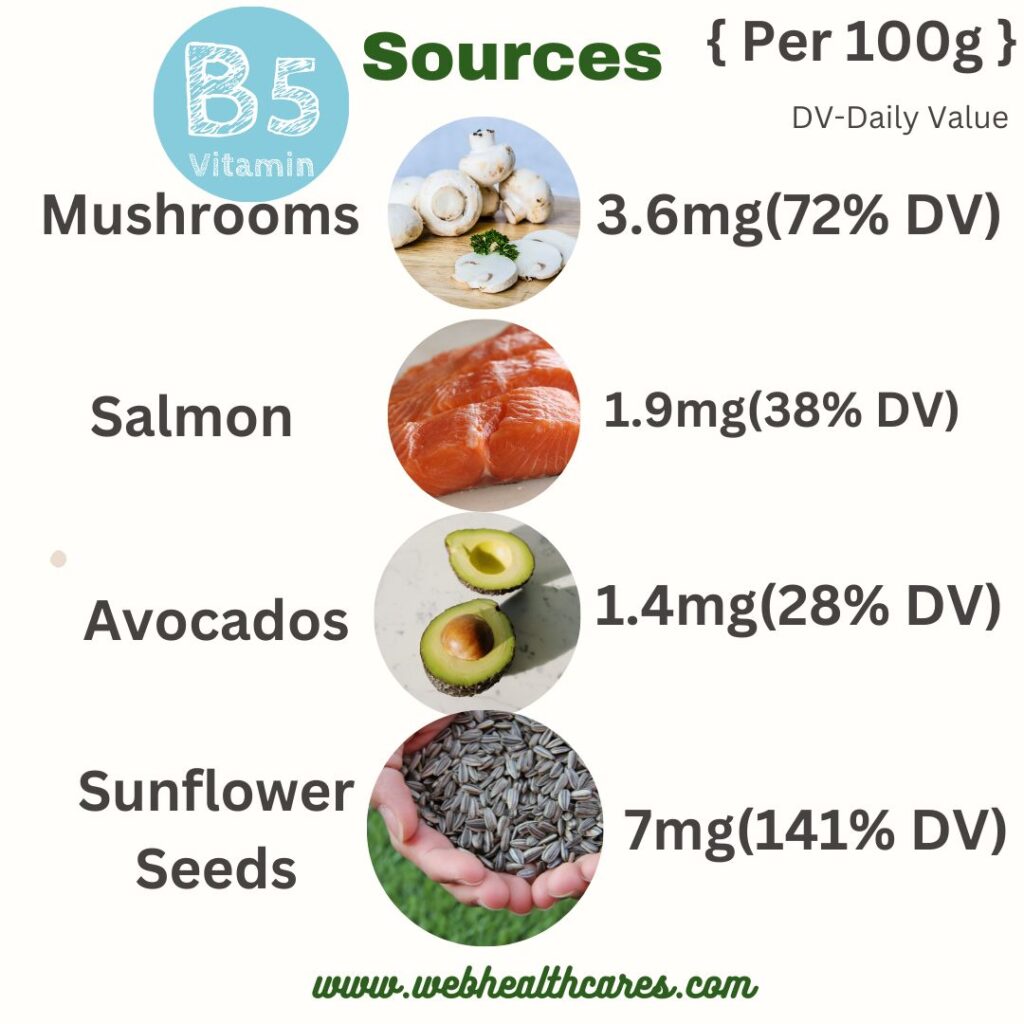- Vitamin B5, known as Pantothenic acid, is a water-soluble vitamin.
- Its main function is energy metabolism, the synthesis of hormones and cholesterol, and the production of red blood cells.
Benefits and function of Vitamin B5
- Proper Energy production:- It helps convert food into adenosine triphosphate (ATP), the energy currency of our cells.
- Healthy Skin and Hair:- Vitamin B5 helps retain skin moisture, contributing to a soft, supple complexion, and preventing hair loss.
- Reducing Cholesterol Levels:- Vit. B5 maintains healthy cholesterol levels, vitamin B5 supports cardiovascular health.
- Improved Digestive Health:- Vitamin B5 supports the digestive system and prevents issues such as bloating, constipation, and diarrhea.
- Promoting a balanced hormonal environment and reducing the negative effects of chronic stress.
- Formation of red blood cells:- Amazing vitamin B5 is important for the synthesis cortisone hormone, and the formation of red blood cells.
Daily Requirement of Vitamin B5
The daily intake requirement of vitamin B5 varies depending on factors such as age, sex, and overall health. The recommended daily allowance (RDA) for vitamin B5 is as follows:-
| Age Group | Male (mcg/day) | Female (mcg/day) |
|---|---|---|
| Infants (0-6 months) | 1.7 | 1.7 |
| Infants (7-12 months) | 1.8 | 1.8 |
| Children (1-3 years) | 2 | 2 |
| Children (4-8 years) | 3 | 3 |
| Children (9-13 years) | 4 | 4 |
| Adolescents (14-18 years) | 5 | 5 |
| Adults (19 years and older) | 5 | 5 |
| Pregnant Women | – | 6 |
| Breastfeeding Women | – | 7 |
Vitamin B5 Rich Food Sources
- In Whole grains: Brown rice, oats, and whole wheat products. One cup (approx. 195 grams) of cooked brown rice provides around 1.2 mg of vitamin B5.
- Mushrooms: Shiitake and other mushrooms are a vegetarian source of vitamin B5. One cup (approx. 100 grams) of cooked shiitake mushrooms provides around 3.6 mg of vitamin B5.
- Legumes:-Lentils, chickpeas, and other legumes are rich in fiber protein, and vitamin B5. A 100-gram serving of cooked lentils offers approximately 1.2 mg of vitamin B5.
- Dairy products: Milk, cheese, and yogurt contain vitamin B5, 2One cup (approx. 244 grams) of low-fat milk provides around 1.5 mg of vitamin B5.
- Nuts and seeds: Sunflower seeds, peanuts, and almonds are examples of nuts and seeds that contain vitamin B5. A 28-gram serving of sunflower seeds offers around 1.1 mg of vitamin B5.
- Avocado: Avocado is a nutritious fruit that also contains vitamin B5. One medium-sized avocado provides about 1.5 mg of vitamin B5.
- Organ meats: Organ meats such as liver and kidney are excellent sources of vitamin B5. A 100-gram serving of cooked liver contains approximately 8.3 mg of vitamin B5.
- Fish: Fish, particularly tuna, salmon, and trout, contain significant amounts of vitamin B5. A 100-gram serving of cooked salmon offers about 1.2-1-9 mg of vitamin B5.
- Chicken and turkey that provide vitamin B5. A 100-gram serving of cooked chicken breast contains approximately 1.3 mg of vitamin B5.
- Eggs: Eggs are a versatile food that provides various nutrients, including vitamin B5. One large boiled egg contains approximately 0.7 mg of vitamin B5.
Should be Know About... Vitamin B3 Niacin benefits and food sources.
Deficiency Disorder due to lack of Vitamin B5
A deficiency disorder that can occur due to a lack of vitamin B5 is known as Pantothenic acid Deficiency.
- Pantothenic acid Deficiency Symptoms:-
- Feelings of tiredness and fatigue.
- Numbness, tingling, and muscle cramps.
- Gastrointestinal disturbances, such as abdominal pain, nausea, and vomiting.
- Acne or pimples.
- Dry, itchy, and scaly skin.
- Hair loss or premature greying of hair.
- Treatment of Pantothenic acid Deficiency:-
- Consuming foods rich in pantothenic acid, such as meat, fish, eggs, legumes, and whole grains.
- Vitamin B5 complex supplements.
- Pantothenic acid supplements.
- Dietary modifications.
- It is important to consult a healthcare professional for an accurate diagnosis and appropriate treatment plan.
READ MORE ABOUT…
Commonly asked questions Vitamin B5 Pantothenic acid-related
Q.1. Which disease is caused by the deficiency of vitamin B5?
Ans.- “Pantothenic acid deficiency.” Symptoms may include fatigue, tingling in the hands and feet, and digestive issues.
Q.2. What is the scientific name of vitamin B5?
Ans.- The scientific name of vitamin B5 is “pantothenic acid.”
Q.3. What is vitamin B5 useful for the skin?
Ans.- It can help keep skin healthy and moisturized. It can promote skin hydration and may be found in creams, lotions, and serums.
Q.4. What is the chemical name of vitamin B5?
Ans.- The chemical name of vitamin B5 is “pantothenic acid.”
Q.5. Who discovered vitamin B5?
Ans.- Vitamin B5 was discovered by Dr. Roger J. Williams in the early 20th century.
Q.6. Can Pantothenic acid be useful for acne?
Ans.- pantothenic acid (vitamin B5) supplements to help manage acne. It’s believed to reduce oil production in the skin, which can be beneficial for acne-prone skin.
Q.7. What is pantothenic acid toxicity?
Ans.- Pantothenic acid is generally considered safe, and toxicity is rare. Excessive intake may cause mild digestive upset.
Q.8. Is pantothenic acid water soluble?
Ans.- Yes, pantothenic acid is a water-soluble vitamin, which means your body doesn’t store it for long periods, and excess amounts are usually excreted by urine.
Q.9. Which method of food production is not destructive to pantothenic acid?
Ans.- Food preservation methods like steaming and microwaving are less destructive to pantothenic acid.
Q.10 How does pantothenic acid help acne or pimples?
Ans.- Pantothenic acid may help acne by reducing oil production in the skin and promoting healthier skin overall.
Q.11. How much pantothenic acid should I take for acne?
Ans.- There’s no established daily dose for using pantothenic acid to treat acne consult with a doctor before starting any supplement regimen, especially at higher doses.

